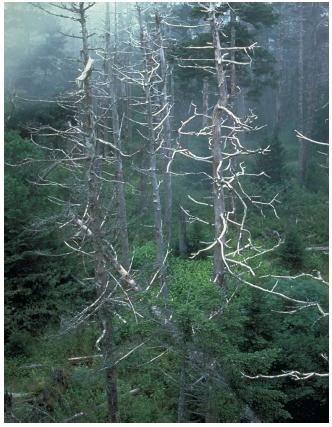Acid rain

Acid rain is a popular phrase used to describe rain, snow, fog, or other precipitation that is full of acids that collect in the atmosphere due to the burning of fuels such as coal, petroleum, and gasoline. Acid rain was first recognized in Europe in the late 1800s but did not come to widespread public attention until about 1970, when its harmful effects on the environment were publicized. Research has shown that in many parts of the world, lakes, streams, and soils have become increasingly acidic, prompting a corresponding decline in fish populations.
Acid rain occurs when polluted gases become trapped in clouds that drift for hundreds—even thousands—of miles and are finally released as acidic precipitation. Trees, lakes, animals, and even buildings are vulnerable to the slow, corrosive (wearing away) effects of acid rain.
Acid deposition
Acidification (the process of making acid) is not just caused by deposits of acidic rain but also by chemicals in snow and fog and by gases and particulates (small particles) when precipitation is not occurring.
The major human-made causes of acid deposition are (1) emissions of sulfur dioxide from power plants that burn coal and oil and (2) emissions of nitrogen oxides from automobiles. These emissions are transformed into sulfuric acid and nitric acid in the atmosphere, where they accumulate in cloud droplets and fall to Earth in rain and snow. (This is called wet deposition.) Other sources of acid deposition are gases like sulfur dioxide and nitrogen oxides, as well as very small particulates (such as ammonium sulfate and ammonium nitrate). These gases and particulates are usually deposited when it is not raining or snowing. (This is called dry deposition.)
Areas affected by acid deposition. Large areas of Europe and North America are exposed to these acidifying depositions. However, only certain types of ecosystems (all the animals, plants, and bacteria that make up a particular community living in a certain environment) are affected by these depositions. The most vulnerable ecosystems usually have a thin cover of soil, containing little calcium and sitting upon solid rock made up of hard minerals such as granite or quartz. Many freshwater lakes, streams, and rivers have become acidic, resulting in the decline or local

destruction of some plant and animal populations. It is not yet certain that land-based ecosystems have been affected by acidic deposition.
Words to Know
Acidification: An increase over time in the content of acidity in a system, accompanied by a decrease in the acid-neutralizing capacity of that system.
Acidifying substance: Any substance that causes acidification, either directly or indirectly, as a result of chemical changes.
Acidity: The quality, state, or degree of being acidic. Acidity is usually measured as the concentration of hydrogen ions in a solution using the pH scale. A greater concentration of hydrogen ions means a more acidic solution and a lower corresponding pH number. Strictly speaking, an acidic solution has a pH less than 7.0.
Leaching: The movement of dissolved chemicals with water that is percolating, or oozing, downward through the soil.
Neutralization: A chemical reaction in which the mixing of an acidic solution with a basic (alkaline) solution results in a solution that has the properties of neither an acid nor a base.
Oxide: A compound containing oxygen and one other element.
pH: A measure of acidity or alkalinity of a solution referring to the concentration of hydrogen ions present in a liter of a given fluid. The pH scale ranges from 0 (greatest concentration of hydrogen ions and therefore most acidic) to 14 (least concentration of hydrogen ions and therefore most alkaline), with 7 representing a neutral solution, such as pure water.
After acid rain was discovered in Europe, scientists began measuring the acidity of rain in North America. Initially, they found that the problem was concentrated in the northeastern states of New York and Pennsylvania because the type of coal burned there was more sulfuric. Yet by 1980, most of the states east of the Mississippi, as well as areas in southeastern Canada, were also receiving acidic rainfall. Acid rain falls in the West as well, although the problem is not as severe. Acid rain in Los Angeles, California, is caused primarily by automobile emissions.
How is acid rain measured?
Acid rain is measured through pH tests that determine the concentration of hydrogen ions in a liter of fluid. The pH (potential for hydrogen) scale is used to measure acidity or alkalinity. It runs from 0 to 14. Water has a neutral pH of 7. (The greater the concentration of hydrogen ions and the lower the pH number, the more acidic a substance is; the lower the concentration of hydrogen ions and the higher the pH number, the more alkaline—or basic—a substance is.) So a pH greater than 7 indicates an alkaline substance while a pH less than 7 indicates an acidic substance.
It is important to note that a change of only one unit in pH equals a tenfold change in the concentration of hydrogen ions. For example, a solution of pH 3 is 10 times more acidic than a solution of pH 4.
Normal rain and snow measure about pH 5.60. In environmental science, the definition of acid precipitation refers to a pH less than 5.65.

Measured values of acid rain vary according to geographical area. Eastern Europe and parts of Scandinavia have rain with pH 4.3 to 4.5; rain in the rest of Europe ranges from pH 4.5 to 5.1; rain in the eastern United States and Canada ranges from pH 4.2 to 4.6, and the Mississippi Valley has a range of pH 4.6 to 4.8. The worst North American area, analyzed at pH 4.2, is centered around Lake Erie and Lake Ontario.
When pH levels are drastically upset in soil and water, entire lakes and forests are endangered. Evergreen trees in high elevations are especially vulnerable. Although the acid rain itself does not kill the trees, it makes them more susceptible to disease. Also, high acid levels in soil causes leaching (loss) of other valuable minerals such as calcium, magnesium, and potassium.
Small marine organisms cannot survive in acidic lakes and rivers, and their depletion (reduced numbers) affects the larger fish who usually feed on them, and, ultimately, the entire marine-life food chain. Snow from acid rain is also damaging; snowmelt has been known to cause massive, instant death for many kinds of fish. Some lakes in Scandinavia and New York's Adirondack Mountains are completely devoid of fish life. Acid rain also eats away at buildings and metal structures. From the Acropolis in Greece to Renaissance buildings in Italy, ancient structures are showing signs of corrosion from acid rain. In some industrialized parts of Poland, trains cannot exceed 40 miles (65 kilometers) per hour because the iron railway tracks have been weakened from acidic air pollution.
Treatment of water bodies affected by acid rain
Usually, waters affected by acid rain are treated by adding limestone or lime, an alkaline substance (base) that reduces acidity. Fishery biologists especially are interested in liming acidic lakes to make them more habitable (capable of being lived in) for sport fish. In some parts of Scandinavia, for instance, liming is used extensively to make the biological damage of acidification less severe.
Avoiding acid rain
Neutralizing (returning closer to pH 7) ecosystems that have become acidic treats the symptoms, but not the sources, of acidification. Although exact sources of acid rain are difficult to pinpoint and the actual amount of damage caused by acid deposition is uncertain, it is agreed that acid rain levels need to be reduced. Scientific evidence supports the notion that what goes up must come down, and because of public awareness and concerns about acid rain in many countries, politicians have begun to act decisively in controlling or eliminating human causes of such pollution. Emissions of sulfur dioxide and nitrogen oxides are being reduced, especially in western Europe and North America. For example, in 1992 the governments of the United States and Canada signed an air-quality agreement aimed at reducing acidifying depositions in both countries.
While countries in western Europe and North American have actively carried out actions to reduce emissions of gases leading to acid deposition for a number of years, countries in other parts of the world have only recently addressed the issue. In eastern Europe, Russia, China, India, southeast Asia, Mexico, and various developing nations, acid rain and other pollution problems are finally gaining notice. For example, in 1999, scientists identified a haze of air pollution that hovers over the Indian Ocean near Asia during the winter. The 3.8 million-square-mile haze (about the size of the combined area of all fifty American states) is made up of small by-products from the burning of fossil fuels. Such a cloud has the potential to cool Earth, harming both marine and terrestrial life.
[ See also Acids and bases ; Forests ; Pollution ]
Could you help me giving some more information to my email about how to take samples and everything that i should know about acid rain.
thank you before...
Could you help me giving some more information to my email about how to take samples and everything that i should know about acid rain.
thank you before...
many peoples like to read this ...
thankyou for your kind information....
It was easy to understand and actually gave detailed definitions of scientific terms.
Thanks again for your help, and I hope I get a good result for Science.
thnx again :D
Sincerely,
Gavin